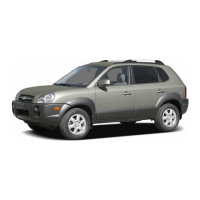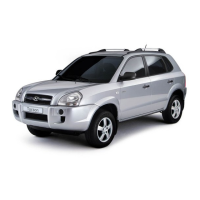Do you have a question about the Hyundai TUSCON and is the answer not in the manual?
Recommendations for fuel types, octane ratings, and break-in guidelines for new vehicles.
Information on vehicle keys, key number recording, and procedures for locking/unlocking doors.
Operation of power windows, adjustable seats, headrests, and seat warmers for occupant comfort.
Crucial information on seat belt usage, precautions, and child restraint system installation.
Overview of the SRS, including components, safety precautions, and occupant classification.
Overview of the instrument cluster gauges and various warning/indicator lights.
Operation of headlights, turn signals, fog lights, hazard lights, wipers, and washers.
Instructions for manual and automatic climate control, including defrosting and air intake modes.
Guide to operating the stereo radio, CD player, cassette player, and related audio controls.
Proper handling, cleaning, and storage guidelines for CDs and cassette tapes.
Warnings about engine exhaust fumes and detailed steps for starting the engine.
Guidance on manual and automatic transaxle operation, sports mode, and general driving practices.
Explanation of TCS, ESC, and 4WD systems, including indicators and operation modes.
Advice on towing trailers, vehicle load limits, and related safety precautions.
Troubleshooting steps for engine starting problems and procedures for handling engine overheating.
Guide to jump-starting a vehicle and understanding the TPMS, including low pressure and malfunction indicators.
Steps for changing a flat tire, handling the spare, and procedures for towing the vehicle.
Tips to prevent corrosion by keeping the car clean, especially the underside, and addressing high-corrosion areas.
Guidelines for washing, waxing, polishing, and cleaning interior surfaces like vinyl and leather.
Instructions for cleaning seat belts and windows, noting care for rear defroster wiring.
Importance of regular maintenance for vehicle performance, warranty, and overview of requirements.
Details on scheduled maintenance items, intervals, and procedures for normal and severe conditions.
Detailed explanations of specific maintenance tasks like checking fluids, belts, and filters.
Identification and regular checks of components in the engine compartment for both 2.0L and 2.7L engines.
Procedures for checking and changing engine oil, coolant, transaxle fluid, brake fluid, and clutch fluid.
How to change the air cleaner filter, climate control filter, and check drive belts.
Guide to checking and replacing fuses, fusible links, and various exterior/interior light bulbs.
Precautions for battery maintenance and procedures for headlight aiming adjustment.
Explanation of the Crankcase, Evaporative, and Exhaust emission control systems.
Information on the catalytic converter's function and warnings to prevent overheating and fire hazards.
Details on VIN, engine number, tire information, and recommended inflation pressures.
Definitions of tire terms, maintenance practices, replacement guidelines, and safety warnings.
Information on vehicle warranties, spare tire usage, shop manuals, and reporting safety defects.
Details on resolving warranty disputes through binding arbitration and the process for revoking the agreement.
Table of vehicle dimensions including overall length, width, height, wheelbase, and tread.
Specifications for fuel system, power steering, tire sizes, and pressures for 2WD/4WD.
Specifications for brake types, battery, and alternator ratings.
Detailed engine specs for 2.0L DOHC and 2.7L V6 gasoline engines, including bore, stroke, and timing.
Table detailing oil and grease standards, quantities, and recommended fluids for various vehicle components.
| Brand | Hyundai |
|---|---|
| Model | TUSCON |
| Category | Automobile |
| Language | English |












